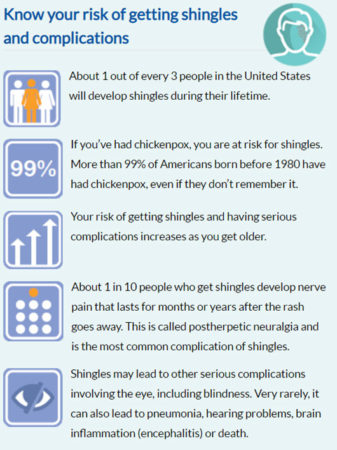Shingles Vaccine: Important After Age 50Shingles Vaccine: Important After Age 50 - National Consumer News | Educating and helping US consumers | Disclose Fraudulent Advertising | Providing News On Lowest Prescription Prices | Shingles Vaccine: Imp...
You might be tired of being lectured about getting vaccinated against Covid, but I'm going to suggest you consider another vaccine – for shingles.
If you are older than 50, your chance of getting shingles is much higher than catching Covid.
I wasn't familiar with shingles until two acquaintances got it and their symptoms were terrible, each had it on their face and suffered from it for months.
Here are some eye-opening statistics from the Centers For Disease Control And Prevention (CDC).

"When the virus wakes up, it causes itching and tingling feelings in your skin that can last up to 5 days. Then blisters appear on your body or face, often in a strip on one side of your body. You also may have a fever, an upset stomach, headaches, and chills," says WebMd.
"The rashes tend to go away within a month, but shingles can lead to long-term nerve damage and pain, especially in people over 50 or are immunocompromised."
Medical News Today says other complications of shingles can include:
- Eye complications. People with shingles in or around the eye have a risk of developing corneal ulcers, glaucoma, retinal necrosis, and partial or total vision loss.
- Pneumonia. The shingles virus can spread to the internal organs, resulting in a condition called internal shingles. People can also develop pneumonia if the virus infects the lungs.
- Encephalitis. If the shingles virus infects the brain, it can cause severe, life threatening inflammation. Encephalitis, or brain inflammation, can cause memory problems, loss of some motor functions, mood changes, epilepsy, and even death.
There is only one way to greatly reduce your chances of getting shingles, and is by taking the two shots of Shingrix over a two to six month period. It is approved by the FDA.
The two doses in the upper arm are more than 90 percent effective at blocking shingles, says the CDC. The protection stays above 85 percent for at least four years after you get the second vaccine.
Even if you already had shingles, you should still get the vaccine.
You can get the vaccine at a pharmacy or from your doctor. And just like a flu vaccine, it doesn't hurt. I can attest to it and I'm not fond of needles.
As with any other medication – including common ones like aspirin – there are side effects to the shingles vaccine.
According to WebMd:
Shingrix can make the area where you get the shot swell or feel sore. Other effects include:
- Many people who get the vaccine have muscle aches, headaches, or feel tired.
- About 1 in 4 people have a fever or an upset stomach.
Younger people are more likely to have these side effects, and they typically last 2 or 3 days.
It's also possible to have an allergic reaction to an ingredient in the vaccine. If you have problems breathing, feel your face or throat swelling, or feel weak or dizzy after the shot, call 911 and get medical help right away.
There is also a minute possibility of long-term side effects from the vaccine.
"In rare cases, the live shingles vaccine, Zostavax, can cause a skin rash or shingles," according to Medical News Today.
"The rash that occurs with shingles can affect any area of the body, but it often appears as a line of blisters that wraps around the torso.
"Within a few days the blisters cluster, and they continue to form for several more days. The blisters can take 2–3 weeks to heal, according to the American Academy of Dermatology."
Medicare Part D plans pay anywhere from all the cost to $164, depending on your plan, according to GoodRx.
Comments
Post a Comment